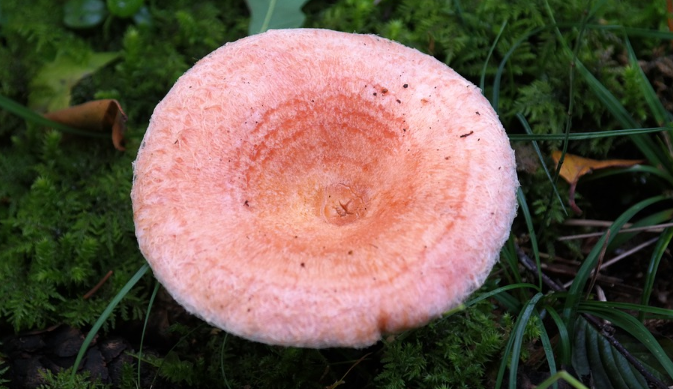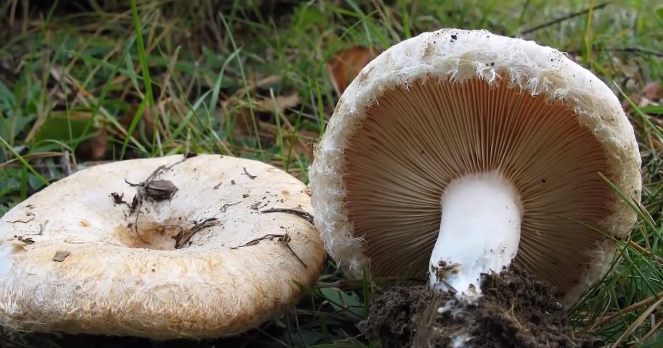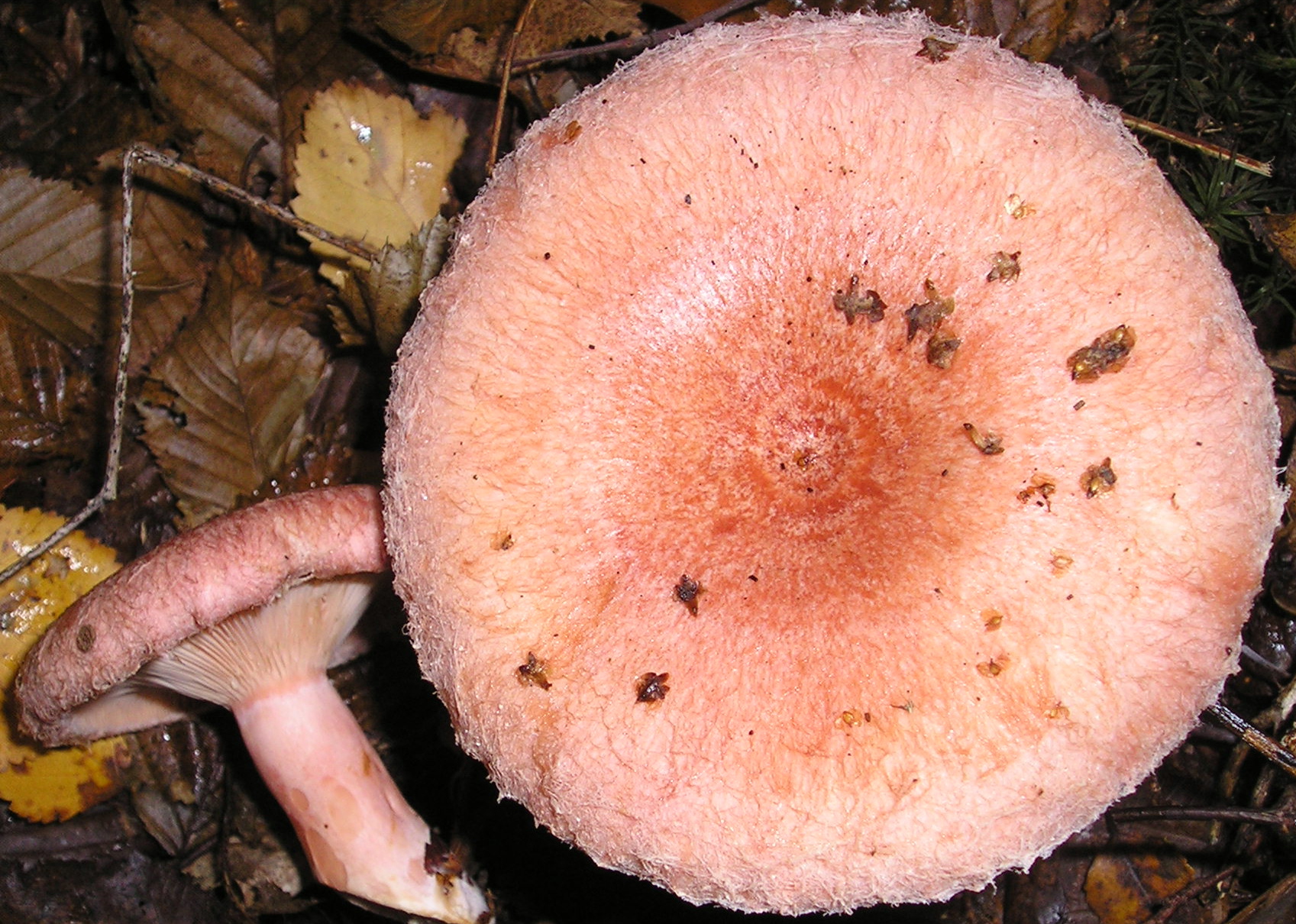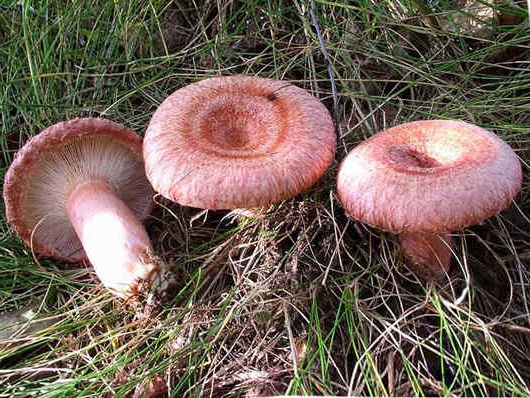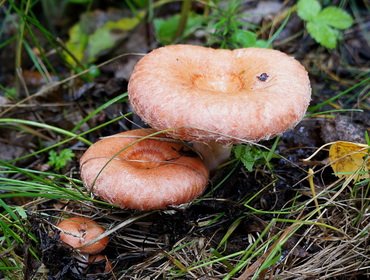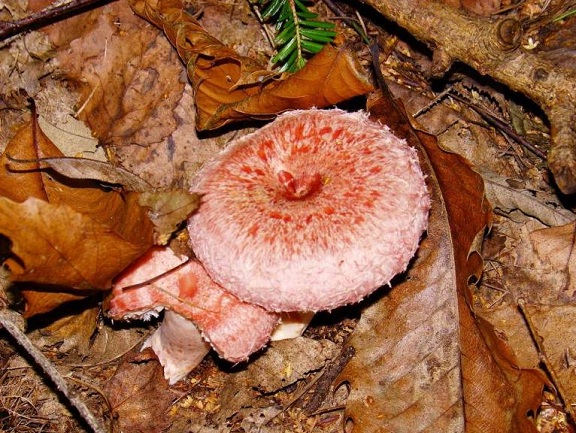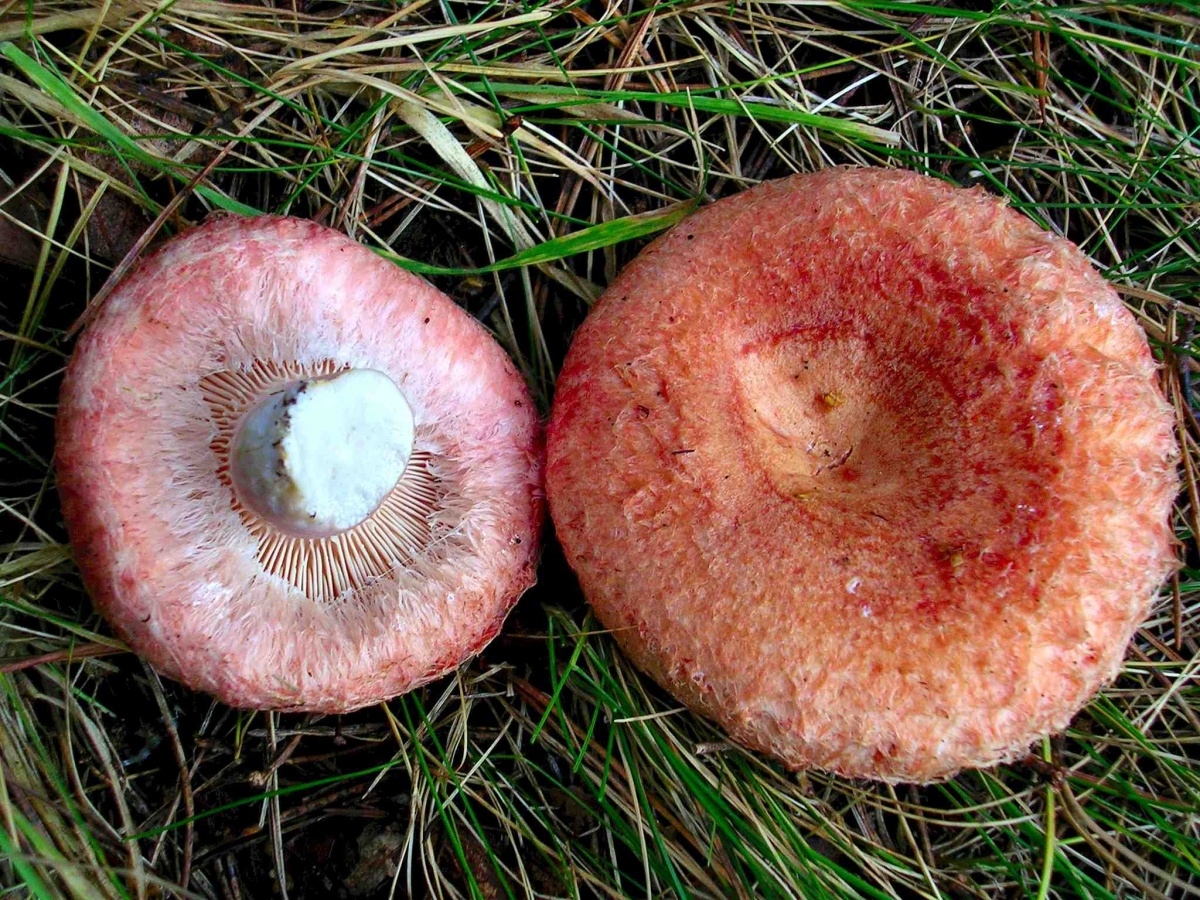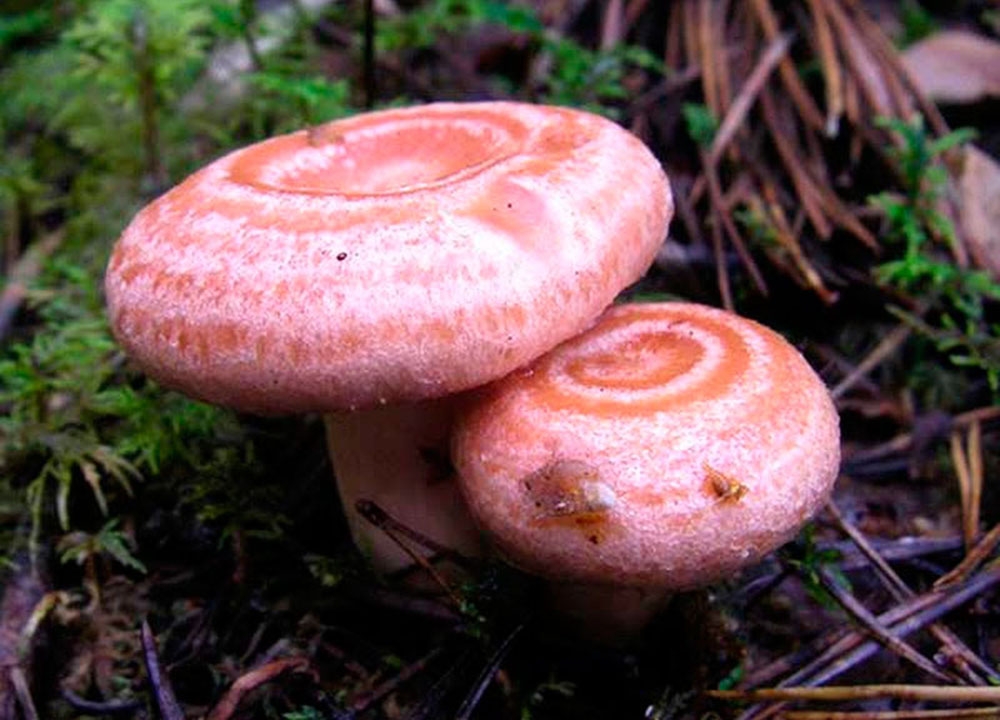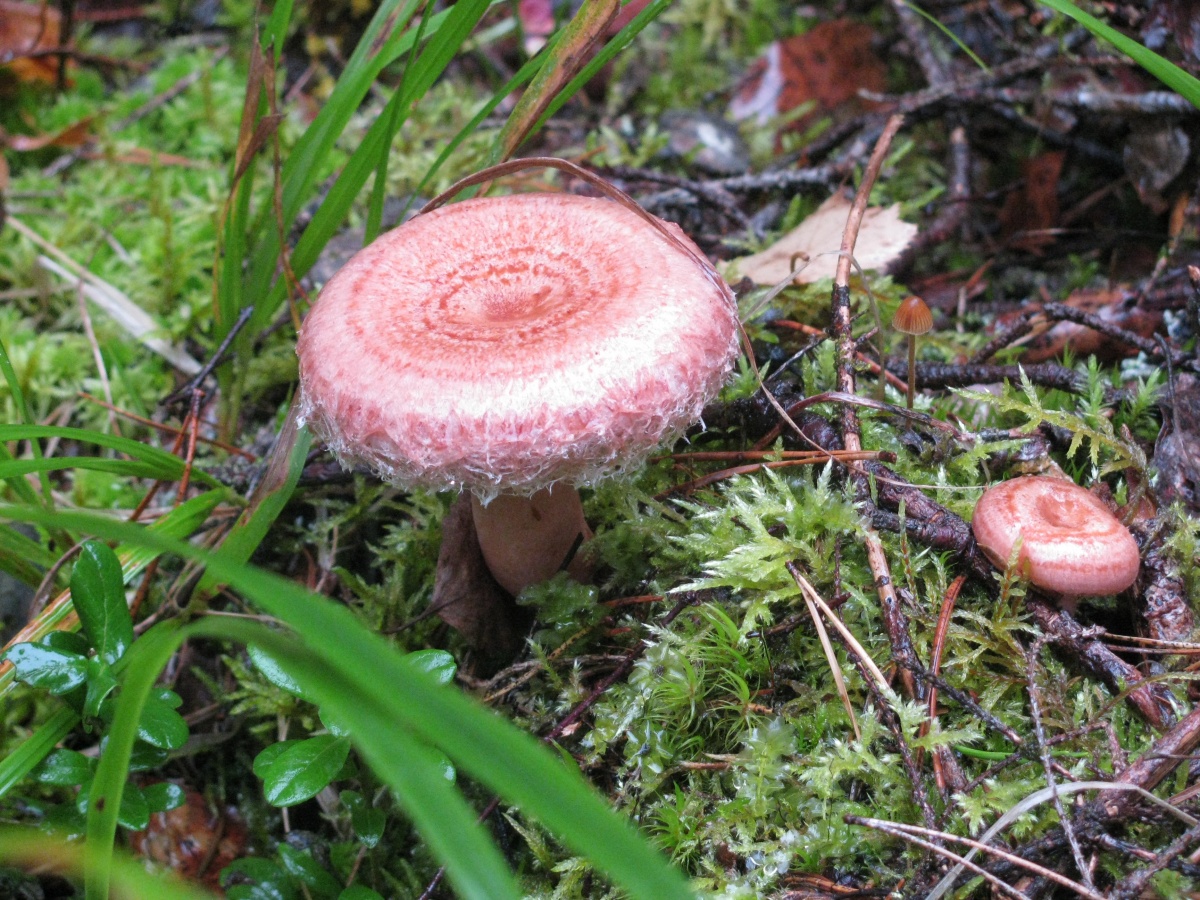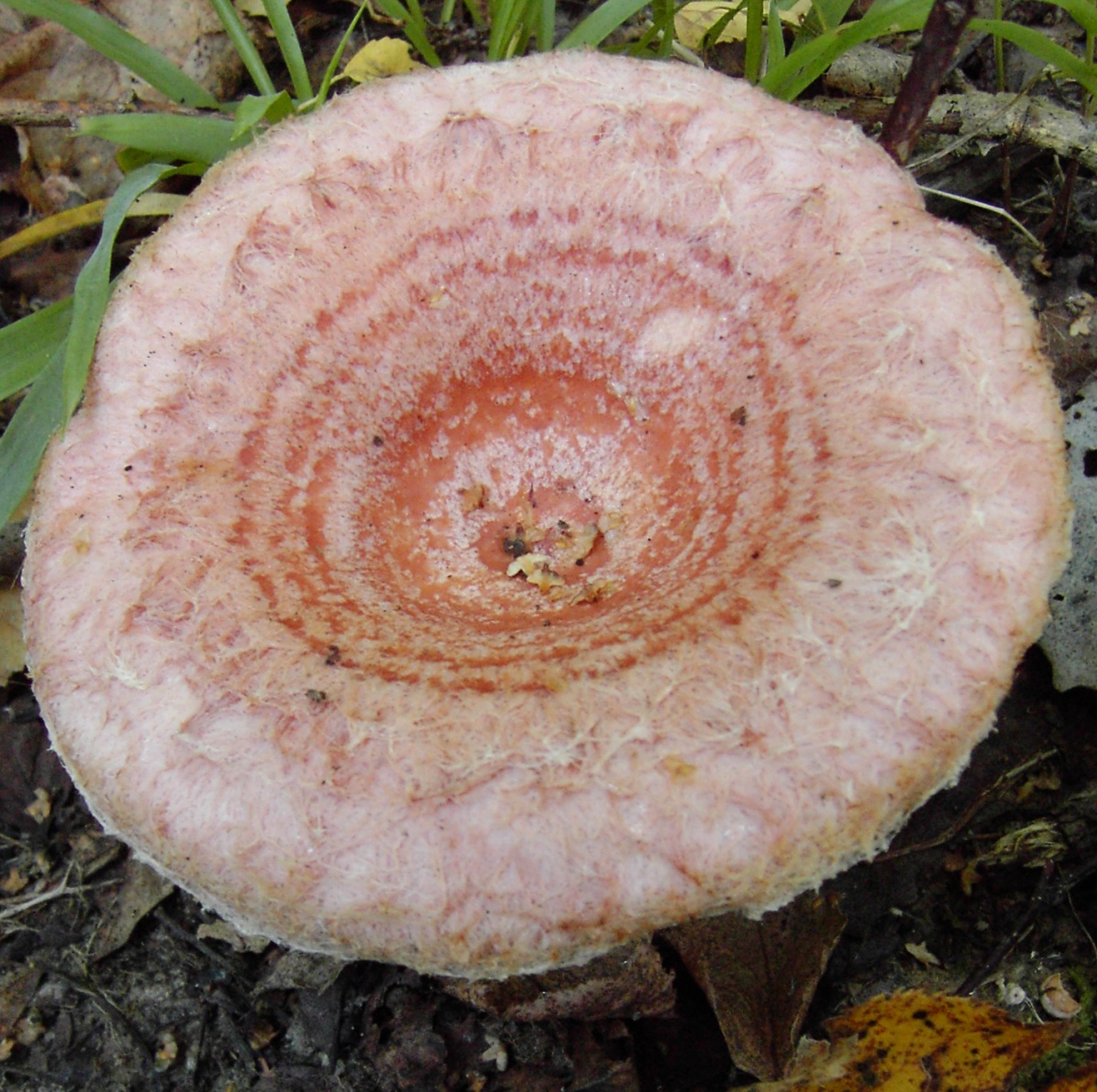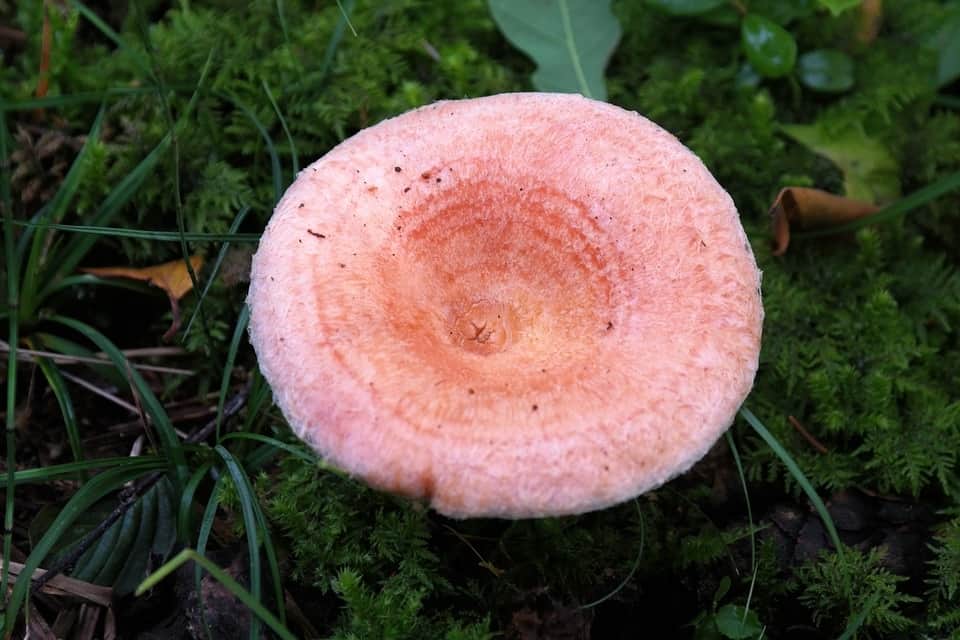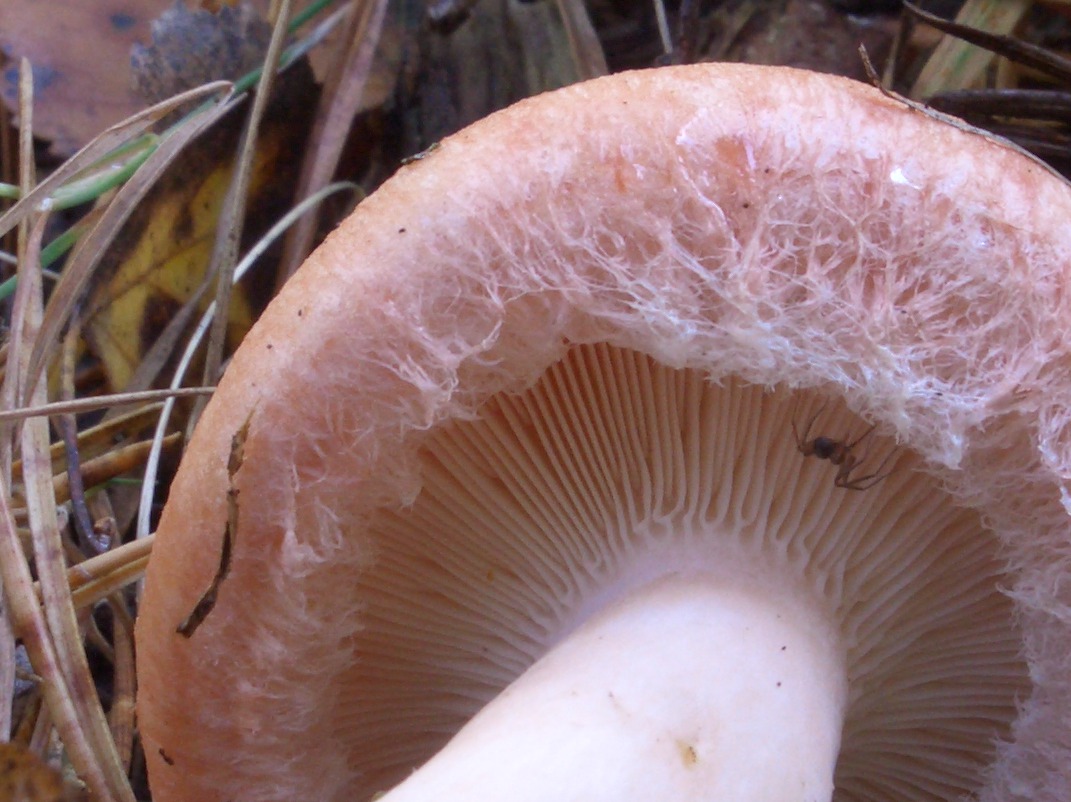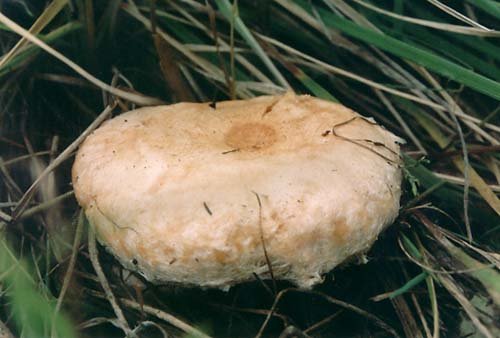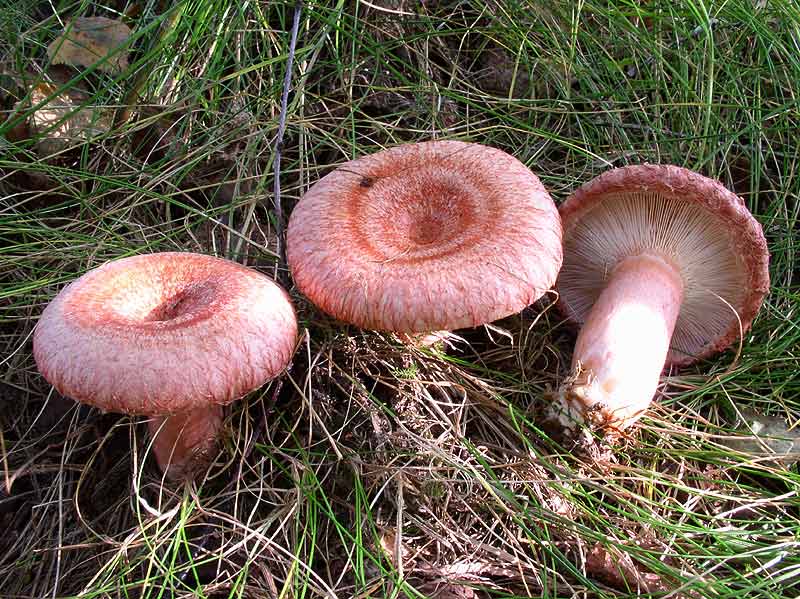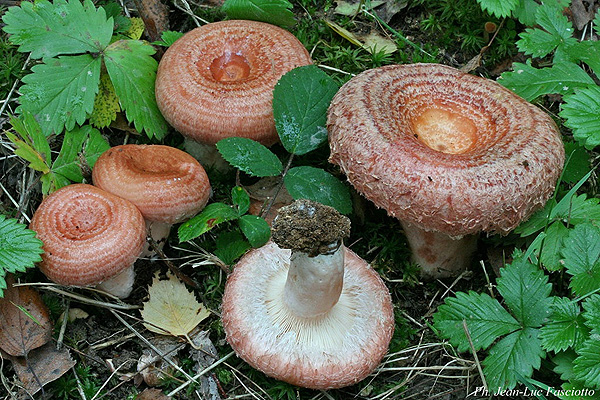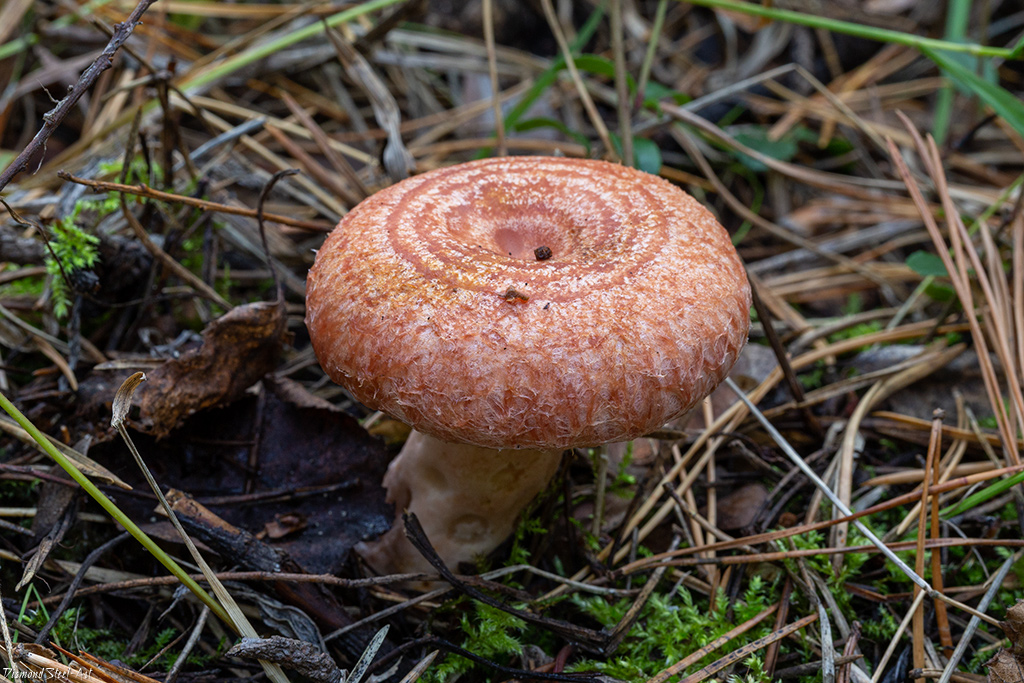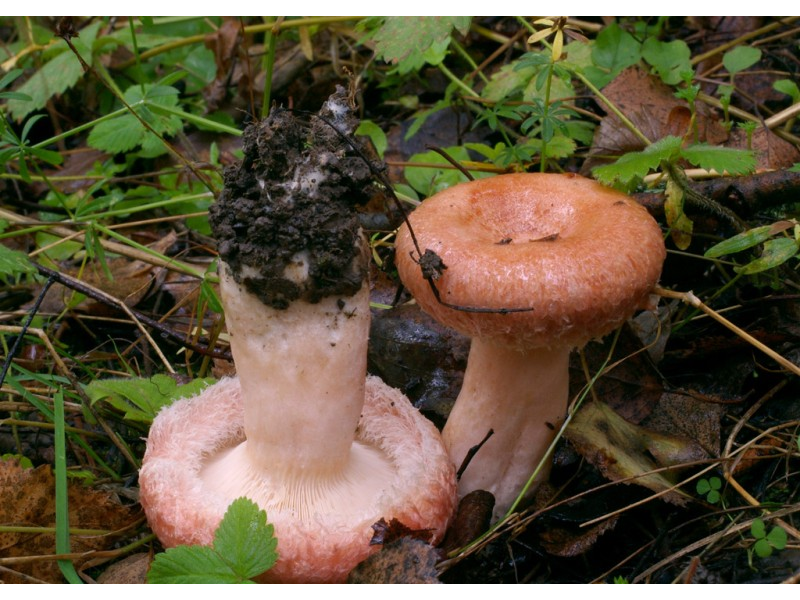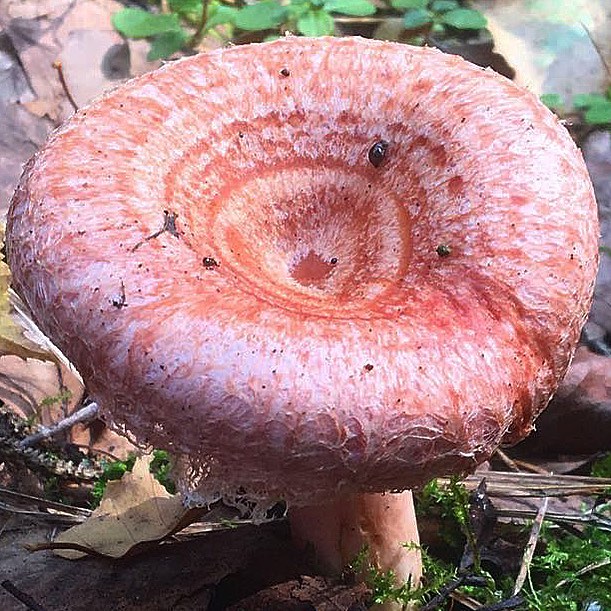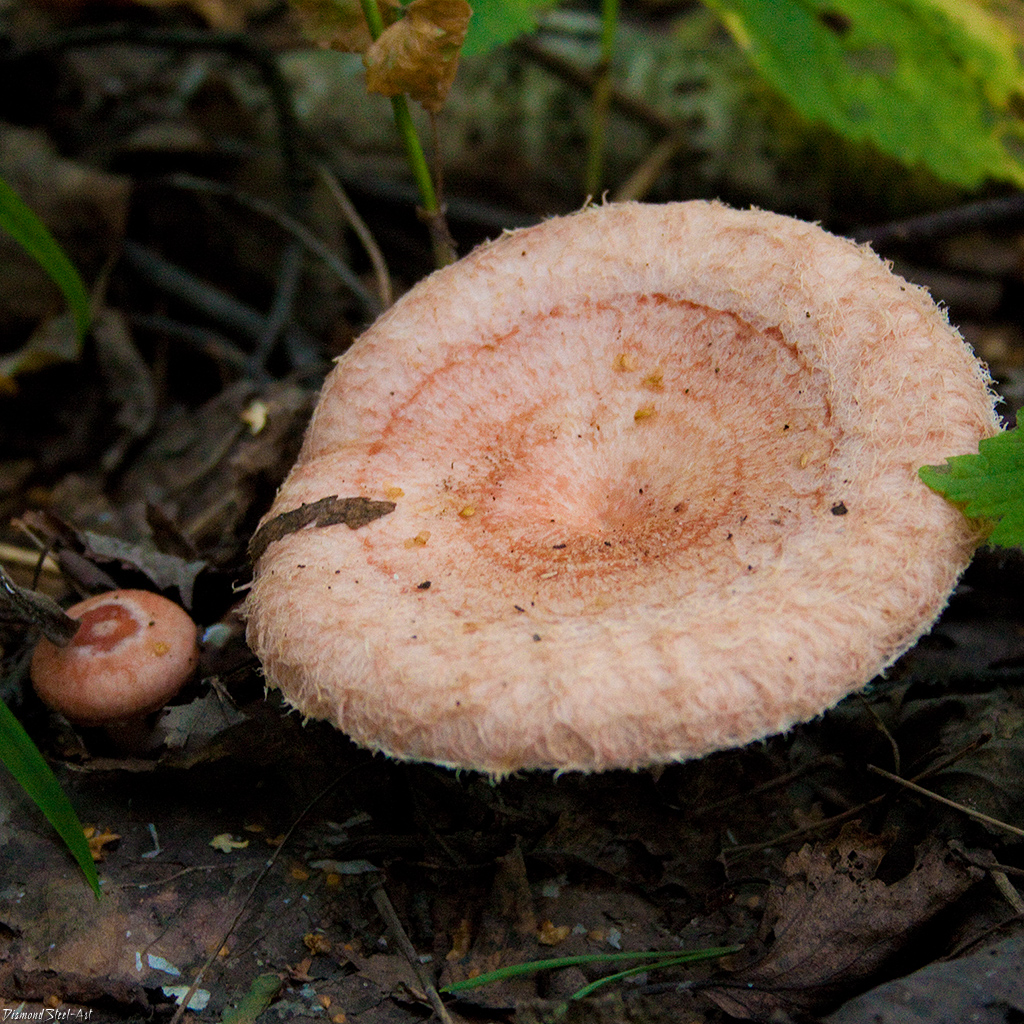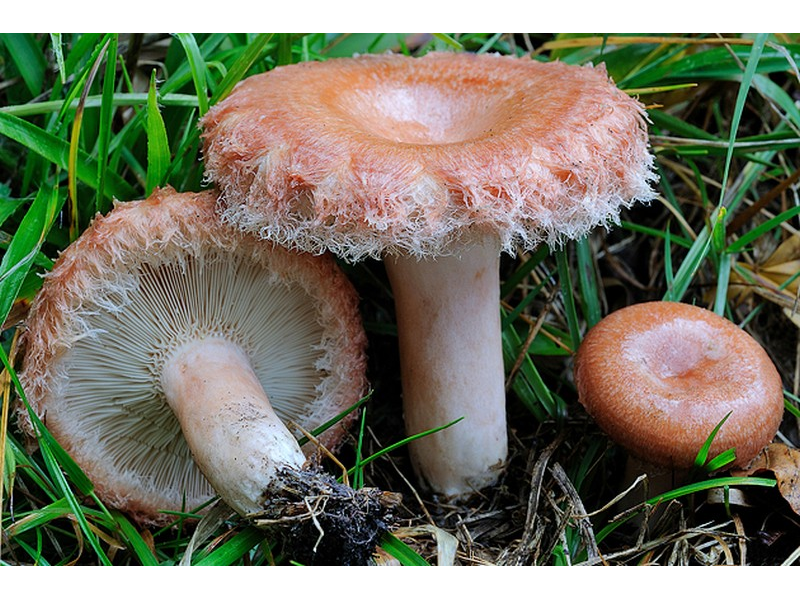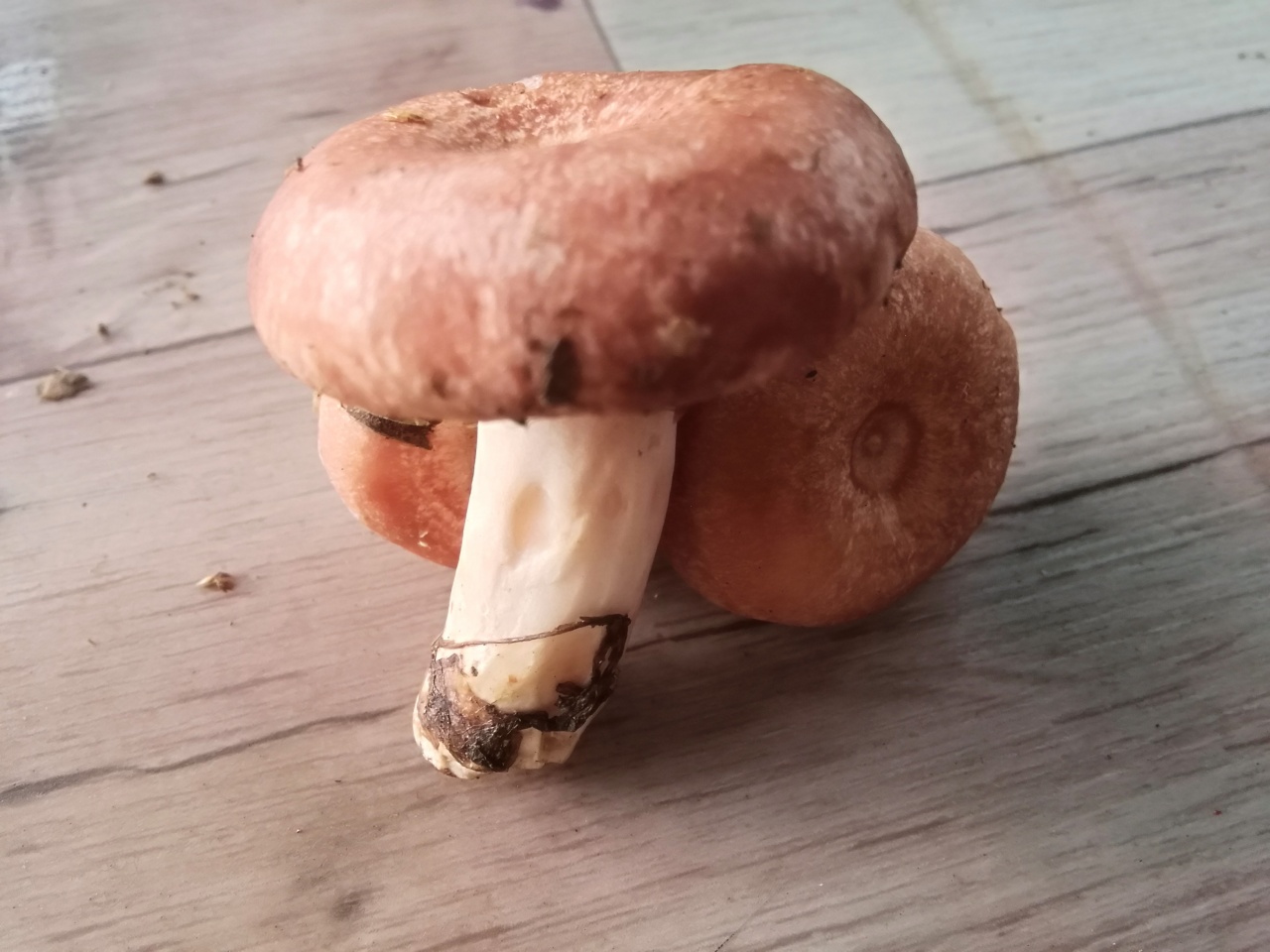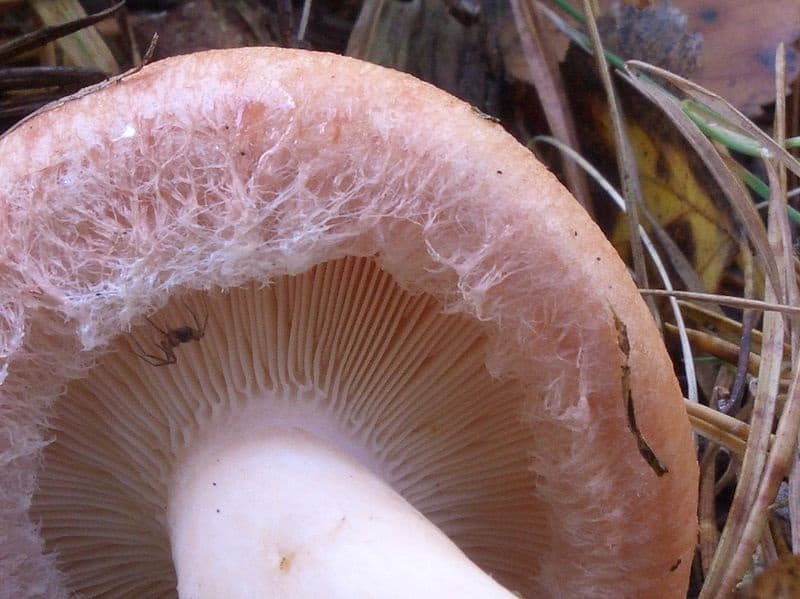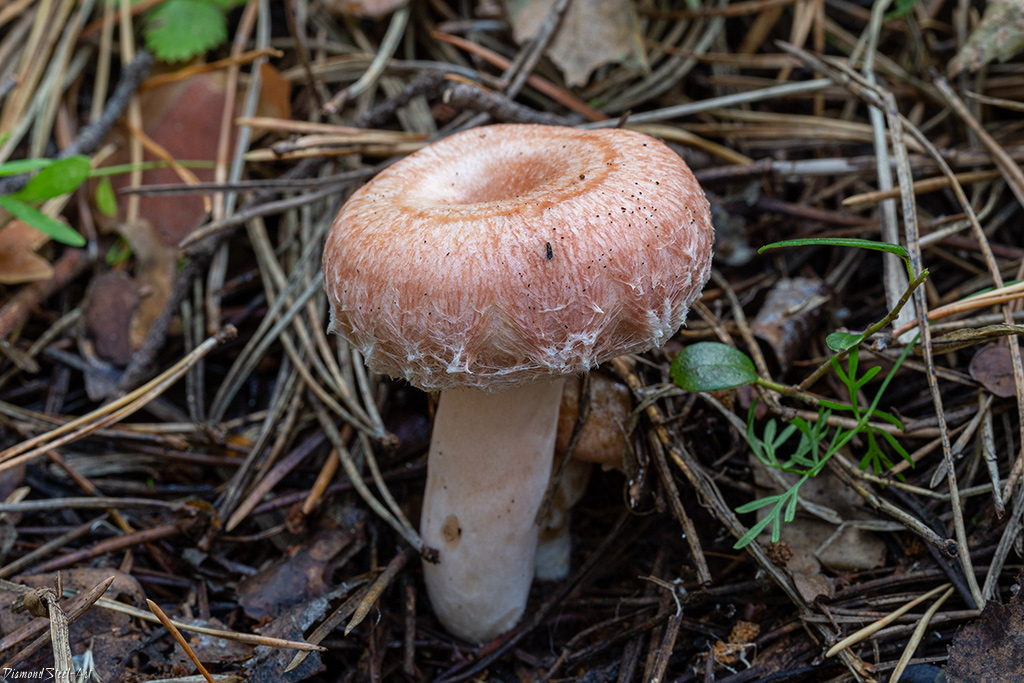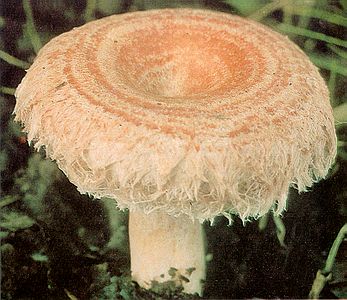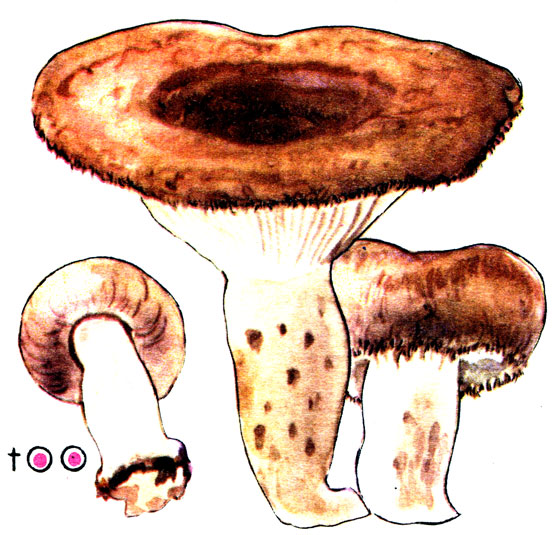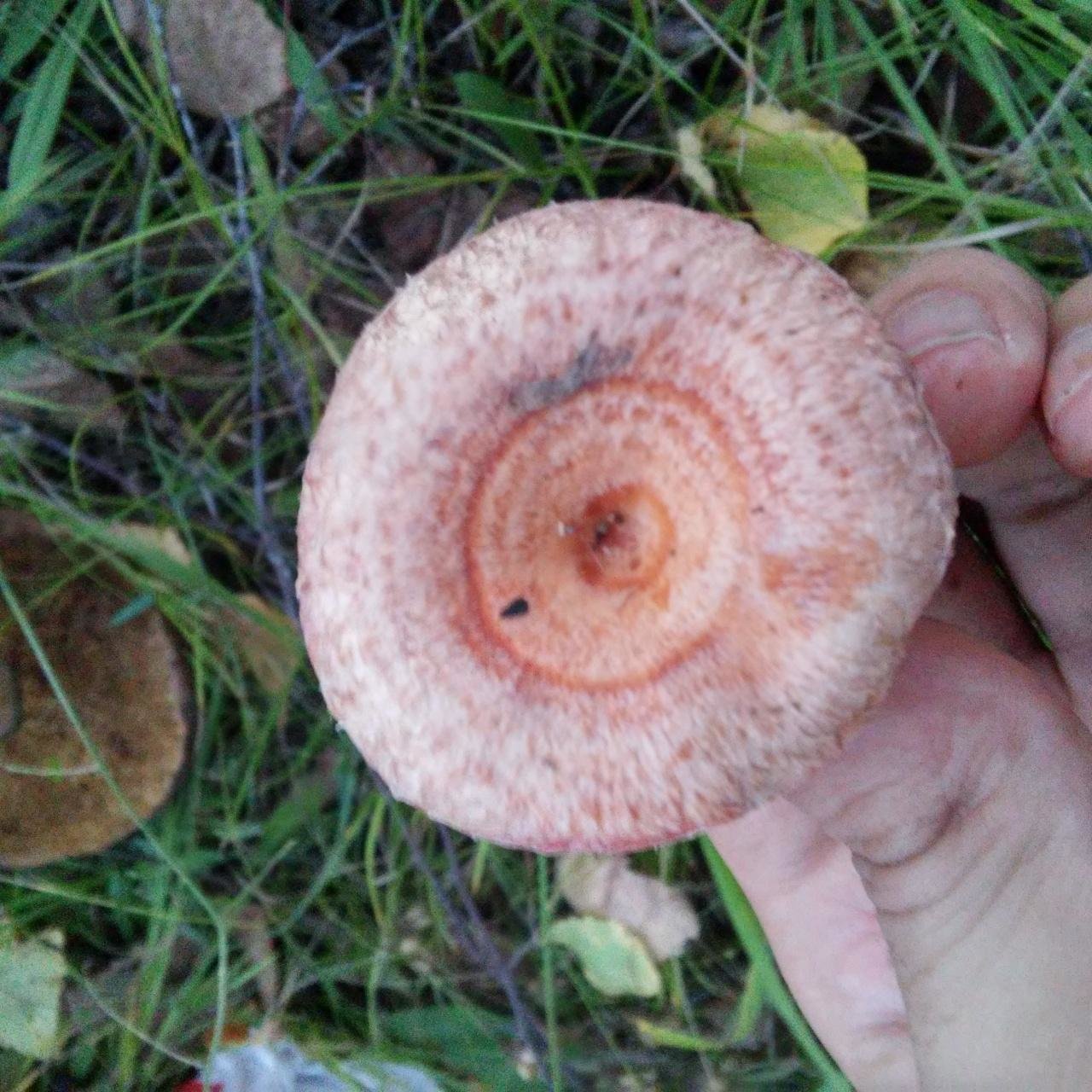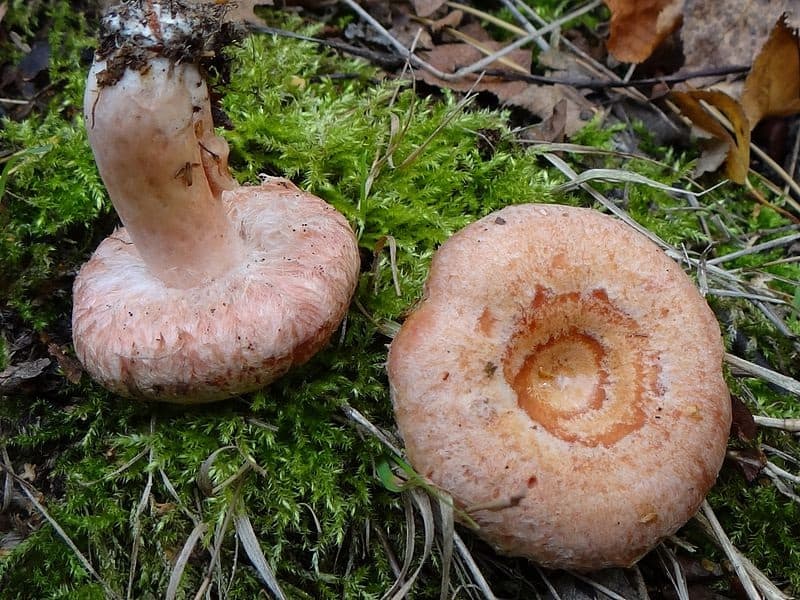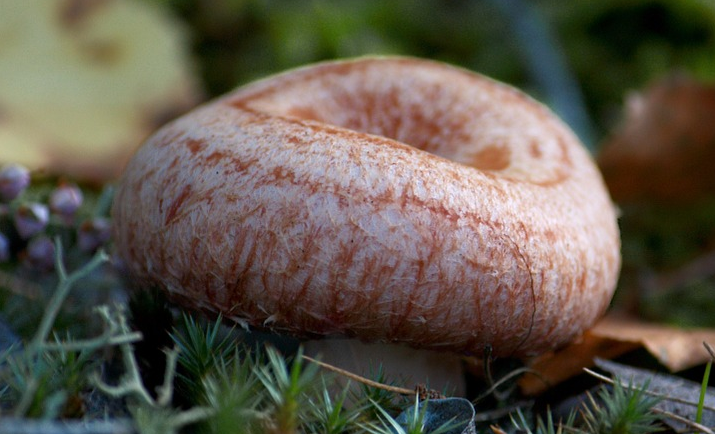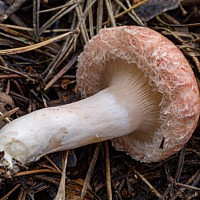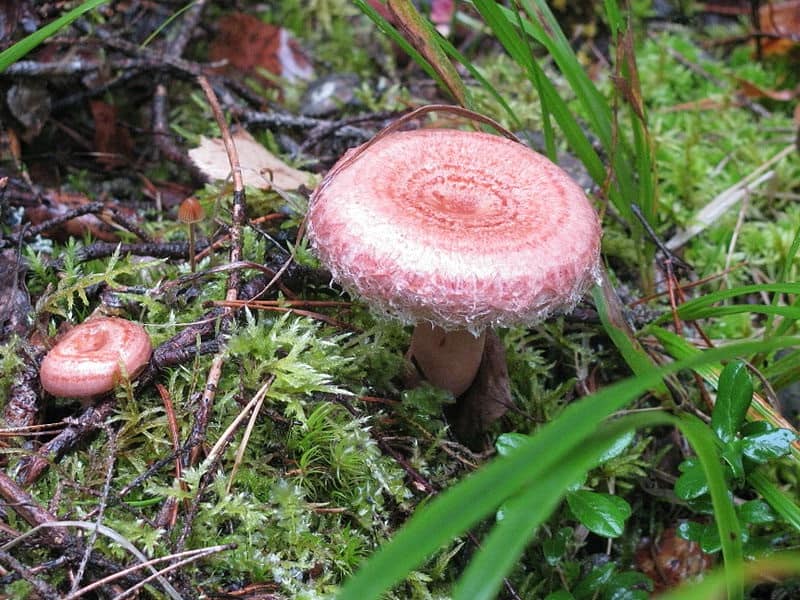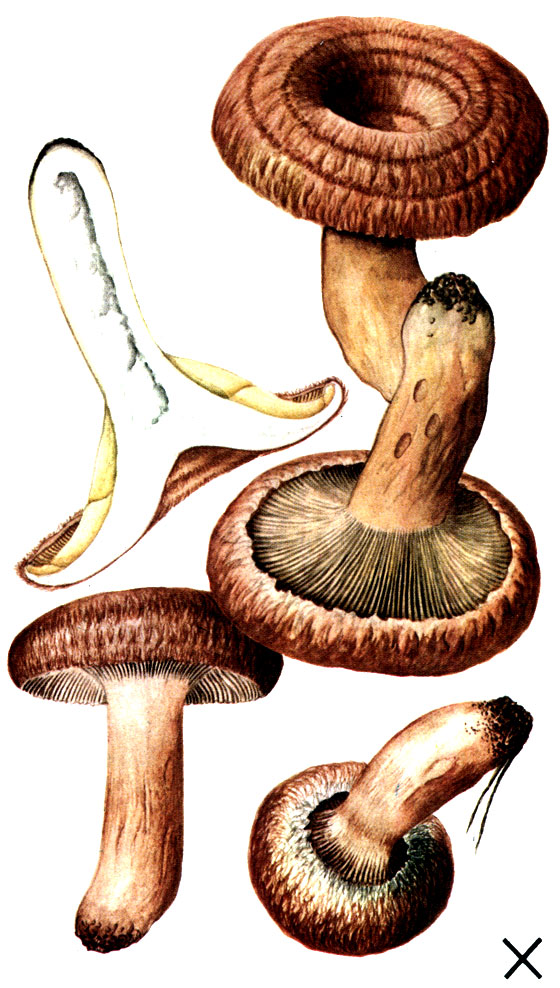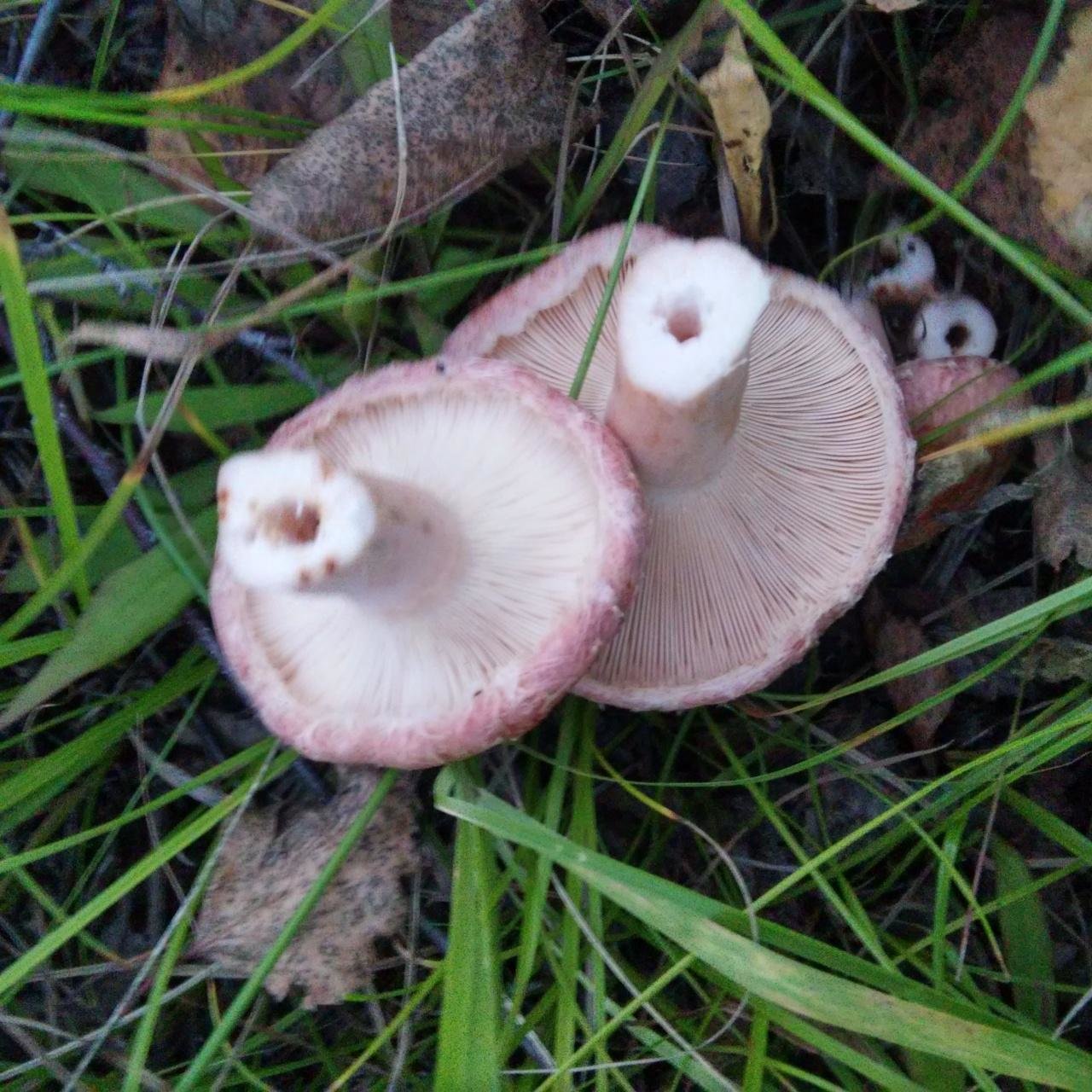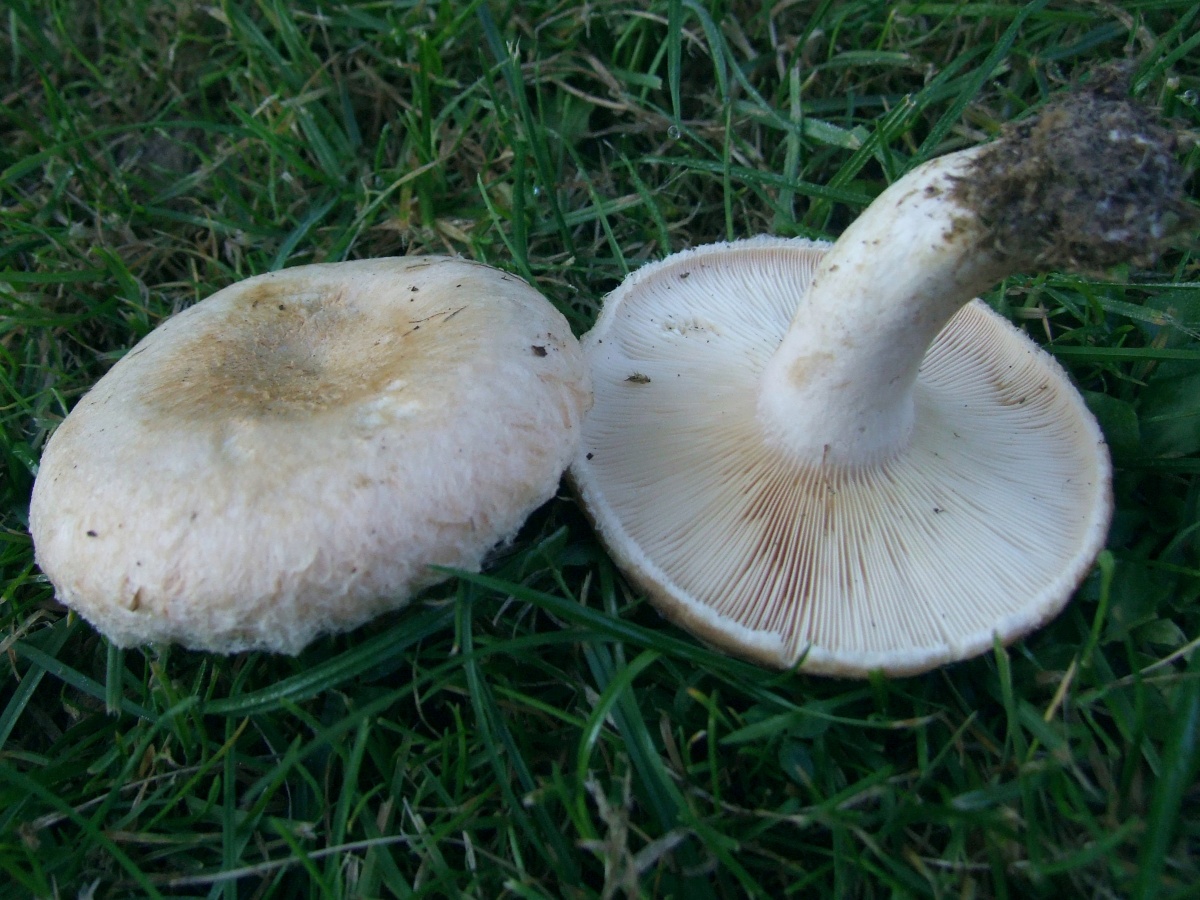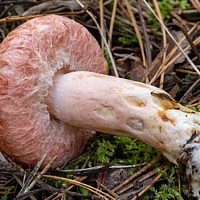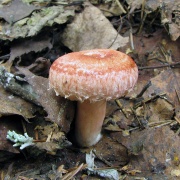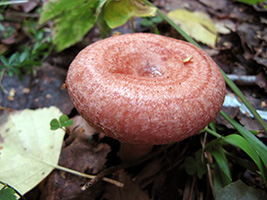How do they look
Volnushki belong to the genus of the lactic, russula family. These are lamellar, conditionally edible mushrooms, which should be thoroughly processed (soaked, boiled) before cooking. There are several types of beetles: white (Lactárius pubéscens), pink (Lactárius torminósus), marsh or Faded Miller (Lactárius viétus). Very often, mushroom pickers call the Milk a real weightlifting wave, but in fact it is an ordinary pink wave.
Description of the pink wave
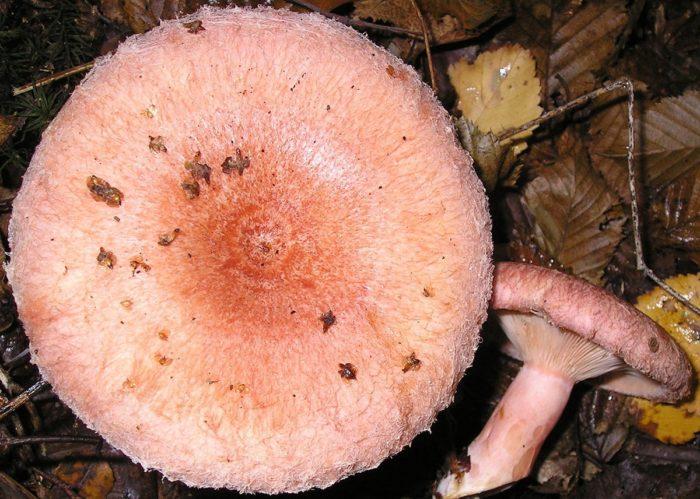
This fungus can be called: Volnyanka, Volnyanka, Volzhanka, Wolfenka, Volvianitsa, Volvianka, Rubella, Krasulya, Broth. The Latin name is Lactárius torminósus.
The cap has a size from 4 to 12 centimeters, in young fruiting bodies it is convex, flattens as it grows. In the center you can see an umbilical depression (funnel), the edges of the cap are lowered. The skin is slightly slimy, has coarse villi arranged in the form of uneven circles. The color of the hat is gray-pink or pale pink, darkens when pressed. If the fruiting body grows in arid places, then the color of the cap fades and fades.
The cut pulp has a dense structure, it is strong, snow-white. The taste is spicy. Milky sap is also white, sharp, very abundantly excreted when the body is fractured.
The hymenophore (the lower layer of the cap) is a whitish with a pink shade of plates, which turn yellow over time. They are not wide, often located, descending along the stem. There are intermediate plates between them. Spore powder is creamy white or white.
The stem is cylindrical, strong, firm, tapering towards the base. In young specimens, this part is solid, becoming hollow with age. The color is pale pink, the surface is covered with fluff and small depressions.
The pink Volnushka was first described by Jacob Christian Schaeffer in 1774, and in 1797 he assigned the binomial name to this species - Lactarius torminosus.
Where it grows and when can it be found
The habitat is mixed with birch and birch forests. It forms mycorrhiza with this particular tree. Grows in groups, mainly in the northern part of the forest zone. Rubella is harvested in the last decade of June, and this process continues until October. Yields peak from late July to late August to early September.
Volnushka white
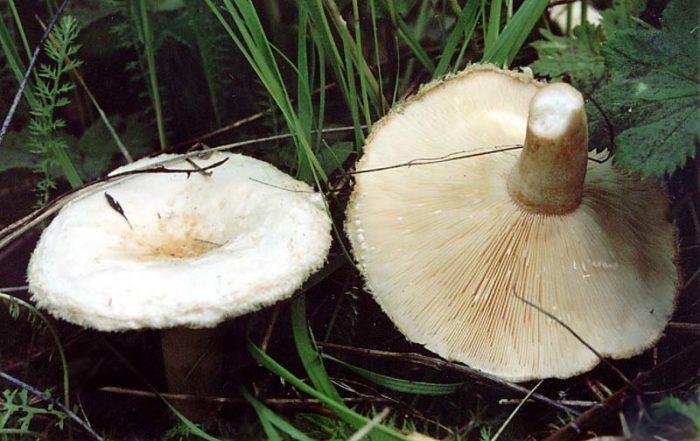
In Siberia, this species is also called whitewater. The Latin name is Lactárius pubéscens. The diameter of the mushroom cap ranges from 4 to 8 cm, it is white, very similar in structure and characteristics to the pink wave.
The hymenophore is an adherent, frequent, narrow plate. Spore powder, milk or cream.
The flesh on the cut is dense, brittle, has a white color and a slight odor.
The stem is cylindrical, of the same color as the cap, smooth or slightly pubescent.
This mushroom was first described by Elias Magnus Fries, a Swedish botanist and mycologist, in 1838, giving the species the binomial name Lactarius pubescens.
Where does it grow
Just like the volnyanka, the whitewash forms mycorrhiza with birch, prefers the edges of birch groves and rare spruce-birch young stands. It is often found in large groups. Fruiting season: early August - late September.
Description, structure and characteristics of the fungus
Belyanka, or White Volnushka, is a mushroom of the Millechnik genus of the Russula family. Other names: Fluffy Belyanka, White milk mushroom, White plate, Volzhanka. Latin name: Lactárius pubéscens.
The fruit body is light cream in color. The size of the cap is 4-6 cm in diameter. In young specimens, it is slightly bent inward, and in adults it is slightly straightened. Its shape resembles a wide rounded funnel, the color is milky, and in the middle, closer to the depression, it is yellowish-pink, without clear lines, blurred closer to the edges. The bottom of the cap can be snow-white, pinkish or light yellow.
The hymenophore (the lower part of the cap) consists of adherent or weakly descending plates, they are frequent, white, narrow; a spore powder of chalk or cream color.
The flesh on the cut is white, fragile; when broken, it exudes a pleasant mushroom aroma. When broken, it releases a snow-white milky juice that does not change color in the air.

The height of the leg can be different, it all depends on the area where the fruit body grows. If it grows in an open place, then the size of the leg will not exceed 4 cm. If the fungus is in tall grass, then the leg can reach 6 cm in height. The thickness of the part is about 2 cm, the shape is cylindrical, tapers downward. The color of the cap and legs are the same.
A bit of history
First described this species and gave it the binomial name (Lactarius pubescens) in 1838 by Elias Magnus Fries, Swedish botanist, father of mycology.
Pink Volzhanka (Volzhanka)
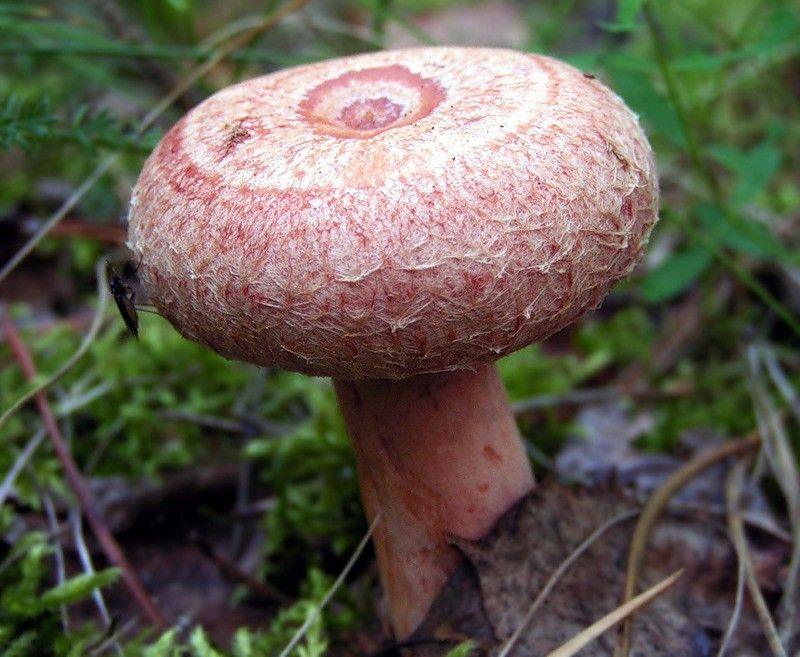
Pink Volnushka (Lactárius torminósus) is a mushroom of the genus Millechnik (Lactarius) of the Russulaceae family. It is a conditionally edible mushroom, belonging to the II category for its nutritional and taste qualities. Popularly known as wolf, broth, wolf, wolf, wolf, rubella, wolf, wolf, krasulya.
Where does it grow
Volnushka forms mycorrhiza with old birches and prefers birch or mixed forest plantations. Grows in well-lightened areas in the middle of the grass. Occasionally found in wetter areas. Grows in groups, but occasionally single specimens can be found. Distributed in northern areas with a temperate climate and sufficient humidity.
The mushroom hunting season begins in July and ends in October.
Botanical description
A distinctive feature of this mushroom is the pink color of the cap. In diameter, it can grow from 4.5 to 11.5 cm. In young fruiting bodies, it is convex, and in older ones it straightens and takes on a flatter shape. There is a depression in the center. The edges are lowered and tucked down. The surface of the cap is covered with frequent and coarse fibers, which are arranged in uneven circles. To the touch, a small mucus predominates, grayish or pale pink, darkening when exposed.

The pulp of Volzhanka is white, elastic and strong, as a result of which it tolerates any transportation well. The taste is spicy.
The plates are narrow, frequent, white, descending, with intermediate plates.
The leg of the wave is in the shape of a cylinder, very hard and strong, solid, becomes hollow in adulthood. It grows in length up to 6 cm, and up to 2 cm in diameter.
Milky sap is abundant, white, and does not change color during oxidation.
Similar species
The pink bollard has some external resemblance to some edible representatives of the mushroom kingdom:
- white wave - differs in pale colors, but in dry sunny weather they can be confused. The size of the cap of this wave is much smaller than the pink one;
- thorny milky - has a smoother and smoother edge. It is also edible only when salted;
spruce mushroom and real mushroom - they are distinguished by the bright orange color of milky juice.
Application and preparation
Basically, volnyanka is consumed in salted or pickled form and fruit bodies no more than 5 cm in diameter are used for this. In order to get rid of bitterness and reduce toxicity, the mushroom is subjected to prolonged soaking and heat treatment. After salting, it is necessary to wait about 2 months before using. If not properly prepared, the pink wave can cause nausea and upset the digestive system.
The use of waves in cooking
You can cook various delicious dishes from the waves. Also, these mushrooms are salted and pickled, getting excellent blanks.
Since they contain a bitter oily juice, it is necessary to properly prepare the waves. You need to follow these recommendations:
- if the taste of the mushrooms is not too bitter or pungent, you do not need to soak them for too long;
- when boiling mushrooms, the first water must be drained and continue to cook them, filling them with a new portion of liquid and having previously doused the waves with cool water;
- for cooking waves, you should not use containers made of tin, copper or cast iron;
- cut the waves with a stainless steel knife.

Pickled waves
To pickle mushrooms, you should use this recipe:
- Take 1 kg of mushrooms, one carrot and one onion, a tablespoon of sugar and vinegar, 3 cloves of garlic, 2 tablespoons of salt, 2 bay leaves, 4 clove buds and a pinch of peppercorns.
- Rinse the mushrooms, remove the villi from the skin.
- Leave small mushrooms intact, for large ones, separate the legs from the caps.
- Put the mushrooms in a container with boiling water. Add a tablespoon of salt to a liter of water.
- Cook the waves for 20 minutes, removing the foam.
- Discard the boiled mushrooms in a colander.
- Cut onions and carrots into rings, each clove of garlic - lengthwise into two parts.
- Prepare the marinade, for which dissolve the specified amount of salt and sugar in a liter of water, add chopped vegetables and spices.
- Boil the marinade. When this happens, add vinegar to it and pour out the mushrooms.
- Boil for 15 minutes.
- Arrange the mushrooms together with the marinade in sterilized jars, roll up. It is better to store pickled waves in the refrigerator.
Salty waves
Mushrooms can be cold pickled. This method of preparation will allow you to preserve all the valuable elements and vitamins that are in these mushrooms. For salting you will need:
- 1 kg of waves;
- head of garlic;
- 5-8 bay leaves;
- dill stalks;
- leaves of currant, cherry and horseradish.
Mushrooms need to be prepared: soak them in cold water for 12 hours, changing the water every 2 hours, then clean them of debris. Separate the legs from the hats.
Peel the garlic, cut into small slices. Put salt on the bottom of glass jars, put dill leaves and stalks. Put some of the mushrooms on this pillow, add salt and pepper, add garlic plates and bay leaves. Put another layer of mushrooms and spices with garlic in the same way. Put the leaves on top.
Put banks under oppression. When the mushrooms give juice and sink to the bottom (this will take several days), put the jars in the refrigerator. After a month, salty waves can be eaten as an independent dish or an ingredient for appetizers, salads, soups.
Fried waves
For cooking, you need a kilogram of mushrooms, 2 medium-sized onions, a teaspoon of ground pepper and 1.5 tablespoons of salt.
You need to cook fried mushrooms like this:
- Rinse mushrooms in cold water, peel.
- Boil the waves in salted water, put in a colander and let dry.
- Peel the onion and chop finely.
- Heat the oil in a frying pan, fry the onion for 5 minutes, then add the finely chopped waves.
- Season with salt and pepper.
- Fry mushrooms and onions for another 7-10 minutes.
Volushka mushrooms have a specific bitter taste, which is why in most European countries they are considered unsuitable for human consumption. But in Russia they love these mushrooms: they are salted and pickled, fried, used in various dishes. To achieve a good taste, the waves should be soaked beforehand.
White hairworm, Lactarius pubescens

Hat: Diameter 4-8 cm (up to 12), depressed in the center, with tightly rolled edges that unfold as the mushroom matures. With age, many specimens acquire a funnel-shaped shape, especially for fungi growing in relatively open places. The surface is very fleecy, especially at the edges and in young specimens; depending on the conditions of propagation, the color changes from almost white to pink, with a dark area in the center; old mushrooms turn yellow. Concentric zones on the cap are almost invisible. The pulp is white, brittle, gives off a milky juice, white and rather pungent. The smell is sweetish, pleasant.
Plates: Adherent or descending, frequent, narrow, white in youth, then acquiring a creamy shade; in old mushrooms, they are yellow.
Spore Powder: Cream.
Stem: In mushrooms growing in more or less open places, it is very short, 2-4 cm, but specimens grown in dense and tall grass can reach a much greater height (up to 8 cm); the thickness of the leg is 1-2 cm. The color is whitish or pinkish, to match the cap. In young specimens, the leg is usually whole, with age it becomes cellular and completely hollow. It is often narrowed towards the base, especially in short-legged specimens.
Distribution: Occurs from early August to late September in mixed and deciduous forests, forming mycorrhiza mainly with birch; prefers young birch forests and swamp areas. In a good season, it can appear in thickets of young birches in huge quantities.
Similar species: The white wave can only be confused with the closest relative, the pink wave (Lactarius torminosus). The latter is distinguished by the rich pink color of the cap with pronounced concentric zones, and by the place of growth (old birches, drier places), and by the figure - the white wave is more squat and dense. However, it is very difficult to distinguish single faded specimens of a pink wave from a white wave, and, perhaps, this is not particularly necessary.
Edible: Good mushroom, suitable for pickling and pickling; unfortunately, the white wave is probably the most caustic of the "noble" milkmen, surpassing in this indicator even the black milk mushroom (Lactarius necator), although it would seem! some other good mushroom (there is no talk about values and violins). Practice shows that insufficiently cooked waves, even after six months of storage in the marinade, do not lose their bitterness.
Author's Notes: This mushroom, a white wave, made the summer of 2003 simply unforgettable. Of course, in that season, all the mushrooms showed their best side, but the waves were something special. Enter a field overgrown with young birches - from any side, from any edge! - and get lost for the whole day. Wade through birch trees with a huge basket for transporting a cat and two bags; to see one mushroom, put a load near it, lie down and, rolling on the belly, break mushrooms and put them in a basket, in a bag, in a bag from a jacket ... It was a naked, shameless hymn to greed. Villagers and newcomers looked at this with wide-eyed eyes: the birch trees were traversed by them up and down, because there were about the same number of boletus as there were waves, but it was the waves that interested me ...
The first such layer took place in mid-July. The second - in the first third of August. The third is in early September. And then I simply forbade myself to look in the direction of those unfortunate birches, because I found myself in the position of God, who created a fundamentally heavy stone: the tank in which I prepared the waves became so heavy that it was difficult to move it even together ...
For some reason, it seems to me that this will never happen in my life.
Ryzhiki - edible mushrooms: photo and description
On this page you will find out when and in what forest mushrooms grow. And you will also see edible mushrooms in the photo with descriptions.
Where spruce mushrooms grow and photos of mushrooms
Category: edible.
Leg (height 3-8 cm): the same color as the cap, very fragile, cylindrical. In young mushrooms, it is solid, with time it becomes almost hollow.
Plates: very frequent, lighter than the cap, turn green when pressed.
Spruce Camelina Plates
Flesh: orange, but in the place of the fracture and when interacting with air, like the milky juice, it quickly changes color to red and then to greenish. Pleasant on the palate, with a fruity aroma.
As you can see in the photo, the spruce mushroom (Lactarius deterrimus) has an orange cap, 3-9 cm in diameter, with a small tubercle in the center. Usually slightly convex, in old mushrooms with a greenish tinge, it may be slightly depressed or funnel-shaped.Very brittle, with slightly pubescent edges. Smooth to the touch, may be sticky in wet weather.
The description of the spruce mushroom is similar to the description of the pink wavelet (Lactarius torminosus) and the true mushroom (Lactarius deliciosus). However, the orange milky sap does not change color in the wave, and the real mushroom is smaller and grows in all types of coniferous forests.
You will find out where you can find mushrooms by going to the coniferous forest. From mid-August to the end of September, literally every spruce forest is covered with these mushrooms.
Eating: delicious in almost any form.
Application in traditional medicine: not applicable.
Other names: spruce, green mushroom.
Red mushroom mushroom: photo and description
Category: edible.
Cap of red saffron milk cap (Lactarius sanguifluus) (diameter 4-17 cm): orange or deep pink, very dense, open or slightly depressed in the center, often with curled edges.
Leg (height 3-9 cm): very strong, cylindrical in shape, expanding from bottom to top.
Pay attention to the photo of a red saffron milk cap: often its leg has small pits or a mealy bloom. Plates: frequent and not wide
Plates: frequent and not wide.
Flesh: fragile, whitish, with red pits and blood-red milky juice.
According to the photo and description, the red mushroom is very similar to the real mushroom (Lactarius deliciosus), but it has an orange-colored milky juice.
When it grows: from early July to mid-September in temperate countries of the Eurasian continent.
Where can you find it: on the soils of deciduous forests.
Eating: delicious in any form.
Application in folk medicine: not used, but scientists were able to isolate the antibiotic lactarioviolin against tuberculosis from red camelina.
Gingerbreads are real, and in what forest do they grow
Category: edible.
Cap of real saffron milk cap (Lactarius deliciosus) (diameter 5-14 cm): shiny, orange or reddish, can be ocher, dark yellow or red-brown. It has characteristic concentric rings and sometimes a white coating. Convex, but over time it changes to almost flat or even depressed. The edges are usually curled towards the inside. Smooth, slippery and slightly sticky to the touch.
Leg (height 4-10 cm): the same color as the cap, hollow, with small gouges. Expands from bottom to top. Maybe with a light fluff.
Plates: thin, the same color as the cap. Turn green from weak pressing.
Pulp: very firm, turns green at the cut site when exposed to air, has a slight fruity odor. The milky juice is light orange in color.
Camelina mushrooms by photo and description are similar to spruce mushrooms (Lactarius deterrimus), red (Lactarius sanguifluus) and Japanese (Lactarius japonicus). Spruce mushroom differs from the present in its smaller size, and also in that it grows exclusively under spruce trees. Red has no rings on its cap and has a rich red milky juice. Japanese produces a reddish milky sap and grows only in the south of Primorsky Krai and in Japan.
When it grows: from early July to mid-September in temperate northern hemisphere countries.
Where to find it: in coniferous forests next to spruce and pine trees, often buries itself in moss.
Eating: Not suitable for drying, but excellent mushroom for pickling or pickling. There are many recipes. These are spicy mushrooms, and with bay leaves, and amazing sauces. Connoisseurs-culinary experts say that real mushrooms cannot be washed, it is enough just to wipe them to clean them of forest debris and dust.
Application in folk medicine: not used, but representatives of traditional medicine were able to isolate the antibiotic lactariovilin from this mushroom, which destroys the tubercle bacillus.
Other names: pine mushroom, common mushroom, gourmet mushroom, pine mushroom, noble mushroom, autumn mushroom.
Botanical description
Ryzhiks got their name from their bright orange, and sometimes even reddish hue, due to the high content of beta-carotene, which in the body turns into retinol or just vitamin A.
The cap of these representatives of the mushroom kingdom ranges in size from 4 to 14 cm. The color is bright from ocher-yellow to dark orange, shiny. The shape is spherical, convex. A depression may form in the middle, and the edges of young mushrooms are tucked up.With age, the edge of the cap straightens, and it acquires a funnel-shaped shape. The surface is smooth, sticky, slightly slippery. There are girdle rings on it, sometimes a whitish bloom. At the bottom of the cap there are many thin orange-red plates that acquire a green tint when pressed.
The leg is small and thin, its height is from 3 to 7 cm, its thickness is up to 2 cm. It coincides in color with the cap, differs only in a lighter shade. Inside, they are hollow, narrowed at the base, small darker grooves are characteristic of the upper part.
The flesh of the saffron milk caps is dense, bright orange in color, turns green when broken.
A thick milky juice is released. It also has an orange color, which turns green when exposed to oxygen.
Characterized by a fruity sweetish odor.
Common types of saffron milk caps
Among the types of saffron milk caps, the three most common are distinguished: spruce, red, real. They are distinguished by some differences in appearance and places of growth.
Real. It is known as pine mushroom, common mushroom, autumn mushroom, noble mushroom.
The hat is shiny, rather large, up to 14 cm in diameter. Convex, round shape. Its surface is of various shades - from orange to red. On the surface there are girdles, sometimes a whitish coating. The edges curl inward, mostly in adult mushrooms.
The leg is thick, high - up to 10 cm in length. Its surface is rough, it can be covered with a small fluff.
The plates are bifurcated, thin, extend onto the base of the peduncle and can occupy no more than 1/3 of its entire length.
Collected in moss from June until frost.
Red. Less common than other species. It is distinguished by a flat, wide, shiny, large cap, reaching a diameter of 17 cm. It has a depressed fossa in the center. The hat is fleshy and has an orange-red color. On contact with water, it does not lose its density and does not become slimy. The edges of the cap in young mushrooms are bent, and in adult specimens they do not bend at all. The difference from other species is the absence of circles of spots.
The leg is dense, strong, short, only up to 6 cm in length. There is a mealy bloom and red grooves. The pulp is dense, brittle, white, with randomly located bright red spots. Characterized by a viscous milky juice of a bright red hue at the fracture site. The plates are narrow, frequent, strongly descending along the stem.
Prefers coniferous bedding. It is found mainly in high-mountainous areas from June to September inclusive.
Japanese mushrooms (lat.Lactarius japonicus),
Spruce. Has a relatively small size. Its cap usually does not exceed 8 cm in diameter, the height of the leg ranges from 2 to 6 cm, and its diameter reaches only 1 cm. The spruce mushroom cap is sticky, light orange with a greenish tinge. When ripe, it brightens. The leg is thin. The pulp with a pleasant smell, fragile, at the cut site first acquires a reddish tint, and then turns green. This mushroom is found under spruce trees in a mixed forest from July to September.
False doubles
The uniqueness and recognizable appearance do not allow the mushroom to be confused with other representatives of the mushroom kingdom. But among the varieties of these mushrooms there are some that are not edible mushrooms. They belong to the 4th class - conditionally edible mushrooms. These representatives are called false doubles of the saffron milk cap. These include:
The miller is fragrant. A small, brown cap is characteristic, up to 5 cm in diameter. Its edges at any age of the fruiting body are concave inward and slightly torn along the contour. The smell is spicy, very strong, like a coconut. They are used in cooking, salted or dried, as a spice for dishes.
Milk papillary or large lactic acid. It is a conditionally edible mushroom. Grows in coniferous forests. The hat is gray-brown in color, small in diameter. The pulp is brittle, white, pleasant smell. Milky sap is white, does not change color when broken.It is recommended to use it as a food product only after thorough soaking and prolonged salting.
Description of the pink wave
The diameter of the cap ranges from 4 to 12 centimeters. In young waves, the caps are convex; as they grow, they change to flat ones. There is a deep umbilical depression in the center of the cap. The edges of the cap are turned down with a pubescent edge.

The cap is covered with a skin with coarse fibers, which are densely arranged in the form of uneven circles. The skin is slightly slimy. The color of the cap is pale pink or gray-pink, if pink waves grow in arid places, then the color fades and becomes almost white. When you press the hat, it darkens.
The flesh is very strong, dense, white. The pulp has a spicy taste. Milky juice is white and does not change in air. This juice is pungent, and it stands out abundantly. The height of the leg does not exceed 3-6 centimeters, and the width is 1-2 centimeters.
The leg is cylindrical, tapering at the base. The structure of the stem is strong and firm. In young mushrooms, the legs are solid, and in mature specimens they become hollow. The coloration of the leg is pale pink. The surface of the leg can be covered with small pits and fluff.

The plates are whitish with a pink tint, over time they turn yellow. The plates are not wide, often located, descending along the pedicle. There are intermediate plates between them. Spore powder is creamy white or white.
Places of growth of pink waves
These mushrooms can be found in birch and mixed with birch forests. They form mycorrhiza with birch, usually with mature trees. Pink waves bear fruit in groups.
The growing places of these mushrooms is the northern part of the forest zone. Harvest of pink waves is harvested at the end of June, and this process continues until October. Yields peak from late July to late August or early September.

Edibility of pink waves
These mushrooms, which are conditionally edible, are used in pickled and salted form. Sometimes they are served fresh as a main course. Before serving, pink waves must be soaked and blanched well.
The pink bucket contains poison that can provoke an upset stomach. During cooking, toxic substances are neutralized. When salted, the pink ones are ready for use in 50 days.
Similar species
The pink wolf looks like a prickly milky, but it does not have a cannon around the edges of the cap.

A related type of pink wave is the white wave. The diameter of her cap ranges from 4 to 8 centimeters. At first, the shape of the cap is convex, then it becomes funnel-shaped, the edges are wrapped, and the center is depressed. The skin of the cap is white, most often in the center it is darker, it can be mucous. Her flesh is brittle, white. An abundant milky juice is released from the mushroom. This juice is pungent and does not change color when exposed to air. The smell of the white wave is weak.
The plates are narrow, white, adherent, slightly descending. Spore powder of cream or white color. The leg height is 2-4 centimeters, and the diameter is 1.2-2 centimeters. The shape of the leg is cylindrical; towards the base it becomes narrower. Its surface is smooth or slightly pubescent, the color is the same color with the cap. As it matures, the entire mushroom turns yellow.
White waves grow in birch forests, often on the edges. Rarely found among young coniferous-birch stands. The harvest season is between August and September. White waves are often found in large groups.

Like pink flippers, white flippers are conditionally edible mushrooms. They are good for pickling.
Inedible mushrooms that look like waves
Mushrooms have several counterparts. Some of them should not be eaten. These include a false wave and some milkmen.
False wave
You can distinguish this species from the rest of the waves by the following features:
- thin pulp;
- the leg is solid inside;
- the young have a tubercle on the cap;
- gray-brown or wine-brown surface of the cap;
- if the plates are damaged, they turn brown;
- brownish tint of the stem surface.
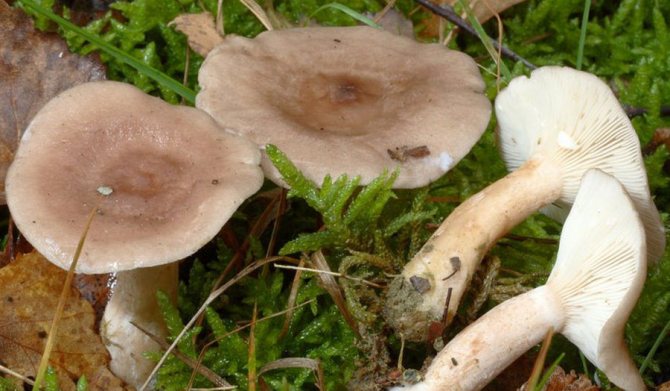
If doubts still remain, experienced mushroom pickers recommend letting out a little juice and waiting until it dries up. In false waves, after drying, the milk will acquire a grayish-green tint.
Millers
Among the inedible milkers, which can be confused with waves, you should pay attention to the following types:
- The miller is thorny. You can identify this type by the color of the cap. Its color is represented by a smooth transition of shades from pink to brown. The edges of the cap are always lighter and the center darker. Representatives of this species are also characterized by the presence of small red scales on the surface of the fruit body.
The color of the flesh can also be considered a distinctive feature. For the overwhelming majority, it is greenish or buffy. But this sign cannot be taken as the main one, since some thorny lactates have white flesh, like that of edible waves.
- The miller is sticky. It can be recognized by several signs. First, the hat is gray-green. There are clearly pronounced dark spots on it. Secondly, the color of the leg does not match the shade of the cap. It is always a little lighter. Thirdly, the milk of these mushrooms sticks to your hands, and when it comes into contact with air, it turns green.
- Hepatic miller. You can identify this species by its glossy olive-brown cap and dark leg. The pulp of these mushrooms is colored with a light brown tone, and the juice released at the break turns yellow in the air.
The rest of the milkmen, with whom the wave is confused, are conditionally edible.
Cooking applications
The answer to the question of what to do with the waves after harvesting sounds unambiguous: soak. Only after this procedure can the product be used for cooking. In this case, the following recommendations must be observed:
- After boiling the liquid, drain it and pour fresh, after sprinkling the mushrooms with cold water.
- Use stainless steel knives for cutting.
- Refuse to use copper, cast iron and pewter cookware.
Recipes for cooking and harvesting mushrooms for the winter
There are many ways to cook mushrooms. You need to know the most common ones:
- Salted. Clean 1 kg of the waves from dirt, separate the caps from the legs. Peel the head of garlic, cut into thin slices. Prepare glass jars, put salt, dill and bay leaves on the bottom. Top with some mushrooms, sprinkle with salt and pepper, add garlic and bay leaf. Carry out the procedure from the very beginning to form the second layer, cover the contents of the jars with currant and cherry leaves. Place under oppression, and after a few days (when the mushrooms let the juice out and go down), move it to the cellar or refrigerator. After 30 days, the product can be eaten.
- Pickled. Rinse with 1 kg of mushrooms. Divide large specimens into 2 parts (cap and leg). Put in salted boiling water (1 tablespoon per 1 liter of water), cook for 20 minutes, removing the foam. Cut the carrots and onions into rings, and cut the garlic (3 cloves) in half. Dissolve in 1 liter of water 2 tbsp. l. salt and 1 tbsp. l. granulated sugar, put vegetables and seasonings (2 bay leaves, a pinch of black peppercorns, 4 branches of cloves). When the liquid boils, add 1 tbsp. l. vinegar and mushrooms. After 15 minutes, remove from the stove, distribute the mixture over sterilized jars. Cool and refrigerate.
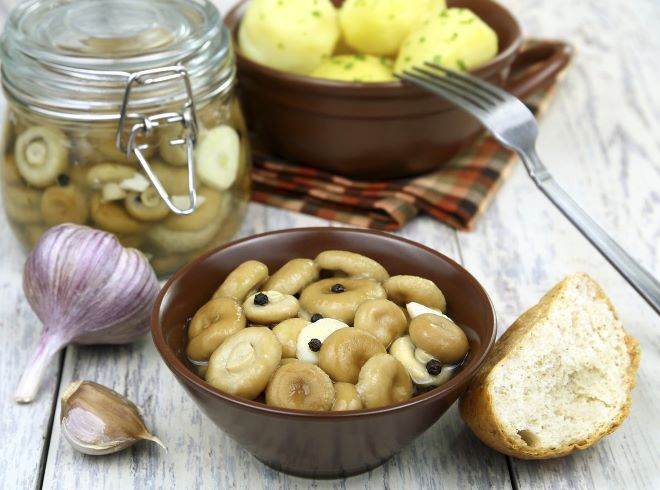
there are various recipes for blanks of waves for the winter
The mushrooms can be fried if desired. To do this, take 1 kg of small bowls, 2 small onion heads, 1 tbsp. l. salt with a slide and 1 tsp. ground black pepper. The mushrooms are washed, peeled, boiled in salted water and laid back on a sieve. The onions are peeled, chopped and fried in vegetable oil for 5 minutes. After that, mushrooms, salt and pepper are added to it. After 8-10 minutes, the dish is served on the table. If desired, sprinkle with finely chopped herbs.
The benefits of the mushroom
Competently cooked young waves (in mature form they are more bitter and less tasty) not only have high gastronomic qualities, but are also useful for human health.
This is facilitated by a harmonious set of nutrients in the form of:
- retinol (A);
- thiamine (B1);
- folic acid (B9);
- nicotinic acid (B3);
- pyridoxine (B6);
- other representatives of the vitamin B group;
- ascorbic acid (C);
- many amino acids;
- fructose;
- glucose;
- lecithin;
- gland;
- calcium;
- magnesium.
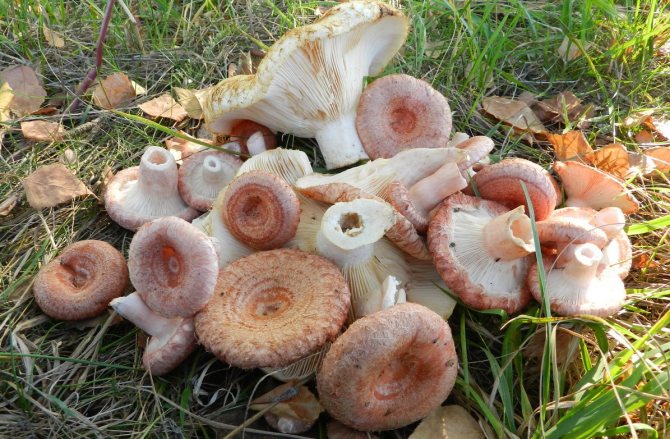
There are 22 kcal per 100 g of waves. The same amount of mushrooms contains 3.08 g of proteins, 0.35 g of fat, 3.27 g of carbohydrates.
- Waves, being a complete food product, are able to have a beneficial effect on:
- strengthening of immunity;
- cardiac activity;
- acceleration of metabolic processes in the body;
- brain activity;
- the condition of the joints;
- lowering the level of bad cholesterol in the blood;
- the condition of the blood vessels;
- quick creation of a feeling of fullness;
- nervous system;
- condition of the skin and hair;
- relieving stress.
Inedible species
The prickly lactarius is dressed in a red-brown or pink hat with little red scales. Its pulp is ocher, sometimes just white or greenish. It does not emit a smell, but the taste will be extremely pungent.
A sticky milky with a cap of a gray-green hue and dark spots has a border lighter than the center. The leg is sticky, paler than the cap itself. White pulp does not emit aroma, but it tastes bitter. The juice is sticky in consistency; when cut, it acquires a green or olive color.
Liver miller - the owner of a smooth brownish cap surface with the presence of an olive tint. When cut, the juice stands out in a yellow tone.

